Flowering flower beds and flower beds at all times were considered the main decoration of the site and the garden. A large selection of colors of modern selection allows you to get raised fantasy and come up with bright and unusual garden compositions. Many gardeners have long been familiar with Sadovaya Gloxinia or Inharvillea, which in recent years has become very popular.
This flower is a real garden decoration, and his type of Inharvillea is done by the view of long and bright blossoms. Beautiful bustard of roasting peristo-separated leaves and high blooms with pink, white or purple flowers - a gentle miracle, landing and care for which it does not work with proper attention to this plant.
In this article, consider the features of Inkarvillei Delaware, we present the basic rules and nuances of planting and care for this culture.
Features and description of Inharvillery Dela
Incarvillee Does is one of the most popular types of Inharvillee, which is a herbaceous flowering plant relating to the begonia family. This is quite an extensive genus of plants, which consists of about 14 different types of inkvillei, characterized by height of cooks, shape, painting inflorescences and frost resistance. All Incarvillee is grassy semi-stabilization plants that can be represented by annuals, twilight and perennial varieties. Inharvillee Delaware belongs to many years of grades of this culture, which perfectly tolerate the moderate climate of the middle strip of Russia, but with very harsh winter, it is still recommended to dig a flower tuber and store them in the cellar or basement.
The natural area of \u200b\u200bthe habitat of gentle and modest colors Incarville is considered the territory of Central Asia, Tibet and the North-West of China. The concrete species of Inharvillea made to the territory of Europe from the North-West of China. Intrvillei made your name in honor of the Frenchman Pierre Nicolas D Inharville in honor of the Frenchman's missionary. It was this man who first gathered just a huge collection of Inkarvillei in natural conditions of growth in China, after which everything described everything literally.
On the territory of Europe, this plant fell about in the 18th century, immediately loved by local landscape designers and gardeners. Inharvillea made in Russia, I was only 40 years ago. The first time was found only in botanical gardens. However, today the popularity of this gentle flower is constantly growing, it can be found in gardens and flower beds almost throughout Russia and even in Siberia.
Inharvillery Description Does:
- In terms of its structure, all the types of Inkarvillei are herbaceous semi-stares.
- In the family there are annuals, twillet and perennial varieties, the type of Inharvillee is done is a perennial and can grow in the climatic conditions of the middle strip of Russia without shelter.
- It is a rather large and branchy bush, consisting of a slightly published stems and foliage.
- The root culture system is very powerful, in appearance resembles tubers Georgin. They are elongated tubers with a large number of branching. These tubers can be used to reproduce this culture. In the strong frosts of Inharvillery's tubers, I am advised to dig up so that they do not frozen. The root length can reach about 20 cm.
- One of the jewelry of Inharvillery is done are her leaves. They are long period-separated leaf plates, which can be 30 cm long.
- All the leaves of this flower are assembled into the root rosette and grow very quickly.
- Dark green or purple leaves have a slightly wrinkled and velvety surface. Therefore, during an active vegetation, this plant looks great at the expense of lush and openwork foliage.
- In the height of Inharvillee, this can reach about 30-50 cm, although sometimes instances can occur to 100 cm in height.
- Blossom Inharvillee Does begins approximately in mid-June and lasts 1-1.5 months.
- The tubular flowers consisting of 5 petals are blooming from buds. Petals have grown, edges are a little bent back.
- Incarvillee Doing pleases with bright pink petals and yellow core. There are also varieties with white flowers.
- Flowers are quite large, in length can reach about 6 cm. Collected into the top-like creeps or blurred inflorescence of 3-4 pieces. However, with proper care, it is possible to obtain a plant that gives in one infloresception to 10-12 bright colors.
- Coloros, together with a cruise inflorescence, can reach a length of 30 cm.
- In about August, fruits are beginning to ripen in the form of small pods in which seeds are located. After full ripening, all pods are bursting and seeds are poured out of them. Therefore, if you want to breed this plant, you should think in advance about the seed collection so that they do not scatter around the district.
- Seeds are quite large, slightly flashed, have a grayish color. Parting material is approximately 3-4 years.
- Inharvillee Does does not differ goodly resistant to frozen. In severe cold, it may not survive, in this case the tubers are recommended to dig.
- Incarvillery has several garden forms: Var Purpurea Hart variety is distinguished by beautiful purple flowers and darker leaves; Sortopean variety is a variety of Inharvillee doing with snow-white flowers.
- Very often, Inkarville is made by the garden Gloxinia for similarity with this beautiful flower.
Inharvillery Proposition Does: The most common ways
The cultivation of Inharvillery Does is not much labor, does not require close attention and complex actions. However, it should be considered when it is breeding the nuances of a particular way so that you have grown a strong and beautifully flowering plant. Inharvillery Pink and White is multiplied with several ways: seeds, stalling, fission of rhizomes and tubers. Each options have its own characteristics that it is important to perform and comply.
Inharvillery's seed reproduction
- Inharvillery Seeds are seeded directly into open soil in autumn or spring. You can use seeds and for growing seedlings.
- It must be borne in mind that the grown seedlings of Inkarvillei through seedlings can be bloated already in the current year, they will also have greater cold resistance.
- Inharvillery seeds are recommended to pretrate to increase their germination. To do this, place the seeds into a wet substrate, the container with which you need to put in the refrigerator for a couple of months.
- Seed seeds to seedlings need in early March.
- Pre-prepare the soil mixture suitable for the cultivation of inkvillei done. For this plant, fertile loose soil is suitable, you can take a garden land, peat sand.
- The soil is desirable to shed a weak solution of mangartage to disinfect it.
- After that, in the surface, the inkarvillei seeds are smeared and the sand is satisfied with sand, whose layer should not exceed 1 cm.
- Sowing need to pour and cover with a film or glass to create a greenhouse effect. Only so seeds will give friendly shoots after a short time.
- To germinate seeds, it is necessary to maintain a temperature of 18-20 degrees.
- The first shoots may appear in 5-7 days, in the worst case - in 2 weeks.
- Further care for seedlings should be in regular watering and proper lighting.
- When the first leaves appear on young plants, seedlings can be divened to separate containers.
- In approximately in June, young seedlings can be planted in open ground.
- Inkarvillei Seeds can be heated immediately into the open ground, so you will get the strongest seedlings. It is necessary to do this in about April-July. The first shoots in this case will appear only after 2 weeks, and your colors will bloom only on the second or third year.
Incarvillee Decoration Decisions
- With this method of reproduction, you can get more healthy and strong young plants, which is why it is applied much more often than the seminal reproduction of Inharvillery is done.
- It is possible to carry in the middle of the leaves in the middle of the summer - approximately at the end of June or in early July.
- From an adult cocus inkvillei, you need to cut strong and healthy leaves with a small part of the stem, approximately 3-4 cm.
- After that, take the container and fill it with a solution of the rooting agent, for example, you can take the cornering. Place all the cuttings in the tank for about 12-24 hours.
- In the greenhouse, prepare the soil that should be loose and fertile and put a cutlery in it.
- After about 2-3 weeks, all the cuttings will be empty small roots. Care must be in regular watering and ventilation.
- When young plants are completely strengthened, they can be transplanted into open ground, while you need to be very careful with roots. It is better to dig up rooted cuttings by transshipment, with a large room of the earth.
- About a year later, Inharvillee Delaware forms a tube rhizome and a rosette of the leaves, at the same time you can observe the flowering of this beautiful flower.
Inharvillery reproduction is done by the division of the bush
- This method can also be used for self-reproduction of inkvillei done, although it is applied to gardeners as often as shilling.
- Sharing the bushes of an adult plant is recommended at the very beginning of spring or at the end of summer. If you have chosen a spring reproduction of a bush, then it is necessary to do this before the start of the active vegetation of the plant.
- It is necessary to carefully dig up an adult plant inkvillei made and put it on a substrate of paper or fabric.
- Next, take a sharp knife or a secateur and divide the bush and its rhizome into two or more parts.
- When separation, remember that each decene should have a healthy rhizome with process and renewal points of new leaves.
- After that, prepare on the site a suitable landing place and place young seedlings into the wells to a depth of about 3-5 cm, but not deeper.
- Abundant sprinkle young ingkarville plants doing.
Incarville's reproduction of tubers
- You can breed an inkviller who made tubers or, as they are also called, Caudex.
- Acquired landing material is planted in March.
- When boarding the tuber of the plant, you follow the growth of the growth kidney to be deepeble no more than 5 cm.
- By the end of July, the leaves will seem on the plant and in the same year you will see the flowering of Inkarvillei done, planted with the help of a tuber.
Preparatory stages before landing Inharvillery doing in open ground
Inharvillea is done, landing and care for which does not make much difficulty, is an unpretentious plant, however, it is important for obtaining a beautiful, healthy and blooming busta to carry out the right preparatory work. This process can take some time and it will be to acquire the planting material of the culture and choosing a suitable place on its site.
Stage 1. Selection of planting material
- If the beauty of Inkarvillea is already growing on your site, you can collect seeds or use other methods of breeding the plant.
- Inkarvillei Seeds can be purchased in specialized garden centers. Prefer proven trademarks.
- Incarvillee Does does not have a large number of varieties, you can choose or inkville pink or white.
- To enjoy the flower already in the current year, you can buy tubers or cakex plants. It is best to buy such a landing material in nurseries where professionally deal with plant breeding. Before buying tubers, carefully inspect them, they must be elastic and integer. It is not allowed to have rotting and faded sites. Also, healthy kidneys should be at the top of the tuber. You can purchase such a landing material in winter and store them before landing in a soil-filled packet with holes for airing.
- In special nurseries and agrofermes, you can buy already prepared seedlings or inkvillei seedlings made in pots. In this case, it is also important to carefully inspect the plants, and they should not be visible damage and signs of diseases and pests.
Stage 2. Selection of Inharvillery landing place
- An important condition for the full growth of Inharvillery is done is the correctly chosen place for landing.
- This plant prefers to grow on well-lit places, but under the right sunlight to plant inkviller do not stand, as she does not like it.
- It is best to choose a place in a mild half, where the flower will show itself in all its glory.
- The selected place should also be protected from strong winds and drafts.
- When choosing an Inharvillery landing site, we think in advance the garden composition you want to get in the end.
- This culture is great for various flower beds, flower beds, polysdents. Plants can be planted along gardens and borders.
- Inharvillea is perfectly feels perfectly in pots and containers that can be put out on the street and contain indoors.
Stage 3. Choice and soil preparation for landing
- Inharvillee Does prefers to grow on fertile soils, it is this contributes to her lush flowering.
- The soil must be sued with good drainage, as the plant does not carry a long stagnation of water from the roots.
- Do not land inkviller on clay heavy soils, there the plant is unlikely to survive.
- Ideal for this culture will fit a place on a small hill.
- Before boarding, carefully disappear on the selected area. This must be done about 1 bayonet shovels to give the soil of lightness and looseness. During treatment, you can add large sand or rubbank to the soil for drainage. You can also make some compost.
Inharvillery Planting Process
- Inharvillery is placed in open ground can be in spring, immediately after the heating of the soil.
- At the selected area you need to prepare landing pits. Their size should be a little more inkvillei root system with an earthen room.
- The soil from the landing holes must be mixed with complex mineral fertilizers, as it is possible to get a beautiful blooming flower.
- At the bottom of the landing holes, be sure to pour the drainage layer to prevent stagnation of water from Inkarvillei's tubers. As a drainage, you can use rubbank, small stones, broken bricks.
- If you bought seedlings or inkvillei seedlings in pots, you must carefully remove them, trying not to damage the root system of the plant.
- Plants are gently placed in the landing pits and sprinkle with the prepared soil in such a way that the root neck of the plant becomes blurred by about 3 cm.
- Hands carefully compact the soil around young plants and plenty of them with water.
- Immediately after landing, young Inkvillei Does need abundant irrigation and shading until adaptation to a permanent place.
- The plant can grow in one place for about 5 years, after which they must be replant and divided into rhizome. The transplant is performed just like planting plants.
Inharvillery Growing Agrotechnology: Secrets and Nuances of Care
Inharvillery's care is pretty simple and should not cause difficulties, but you still have to pay attention to this plant. Constant care and care will help you get a beautiful, flowering plant.
- Watering. Inharvillee Does can fully grow and blossom only with due dignified soil. But it is not necessary to strongly overlook the soil, although drought for this culture is more harmful. It is important to properly observe watering mode. Focus on the state of the soil, you do not need to allow complete drying, the soil must be constantly wet. Usually there is enough 2-3 irrigation a week if there are no natural precipitation. At the same time, it is necessary to water the inkvillya deeply, since the root system penetrates the soil.
- Loosening and mulching. Regularly need to loose the surface of the soil, so that the soil is saturated with oxygen and becomes loose and easy. Swimming are carried out after irrigation. You can also climb the soil around the plants, it will help regulate the evaporation of moisture.
- Undercalville makeup. Regular feeding are needed by a plant for magnificent and prolonged flowering, but it is not necessary to overflow inkvilleu - it can be less resistant to frost. If you made mineral fertilizers during the landing, then the subsequent feeding should be carried out only for the second year. Ideally, the plant needs two mandatory feeding. For the first time, organic or special fertilizers are brought in spring before starting active vegetation, the second time complex mineral fertilizers can be made in the middle of summer during the formation of buds. Later, the feeding is better not to do that the plant can be easier to move the winter.
- Wintering. In the winter, Inharvillea is done, it is necessary to protect against temperature drops and impassing weather. To this end, the plant is sprinkled with a mulch, which is necessary to use a thick layer of false foliage and sawdust. Then everything is covered with a sweetheart, and with very strong frosts you can build a shelter of glass. Early spring is important to remove everything in time so that the plant does not die. You can also fall in the fall of the inkvillei tubers in the morning and store them in sawdust in the basement or in the refrigerator, and in the spring again fall on a permanent place.
Using Inharvillery Does In Landscape Design
Incarvillee Does is a very beautiful and gentle plant, which is often used to design gardens, polysdents, to create original garden compositions.
- First of all, the inkvilleu is done can be used in single landings on the background of lawn. Beautifully look bright pink flowers on the background of green lawn.
- These flowers are an excellent decoration of flower beds and flower beds, where the main focus is put on pink color.
- This flower is suitable for creating a garden composition in country style.
- You can land inkvillya doing on alpine rols, rockers, stone gardens. They look very interesting in such landings on the background of small stones.
- Inharvillea can be decorated with garden tracks and paths. May act as a border culture.
- You can grow this flower for cutting, especially beautifully they look at the formation of buds.
- Inharvillery is made can be grown in pots and containers on terraces, balconies and indoors.
Photo of Inharvillee Delaware
Inharvillee is done very beautiful and gentle flower, which at first glance seems unspoic and timid. But, putting it on his site, you will be completely appreciated by his refined beauty, and there is no special care for this plant.

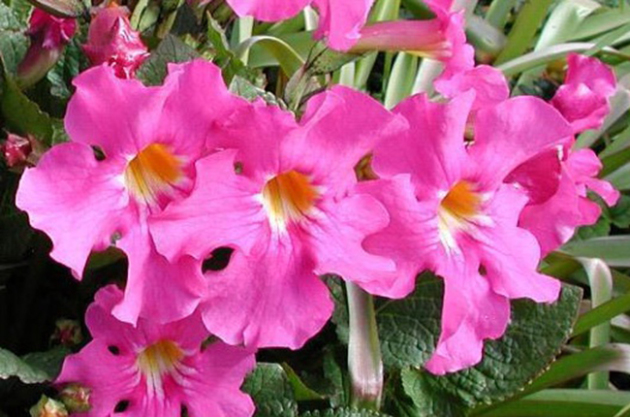
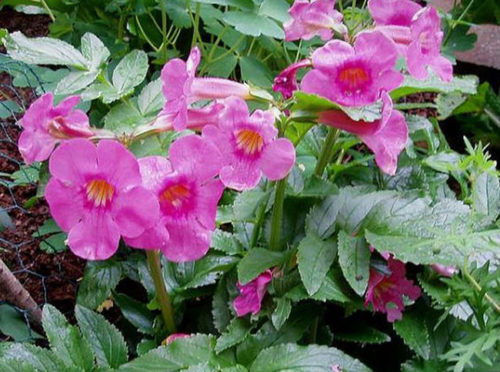
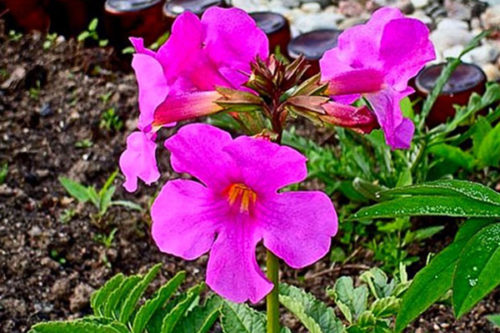
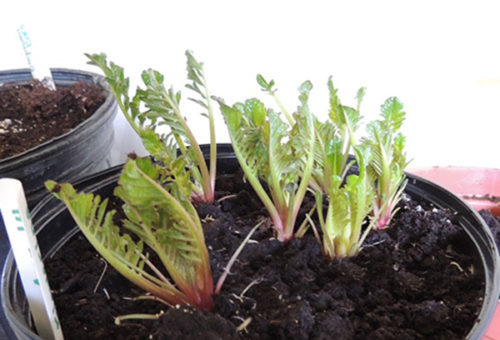
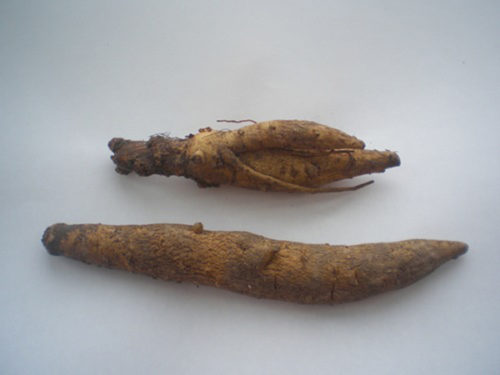

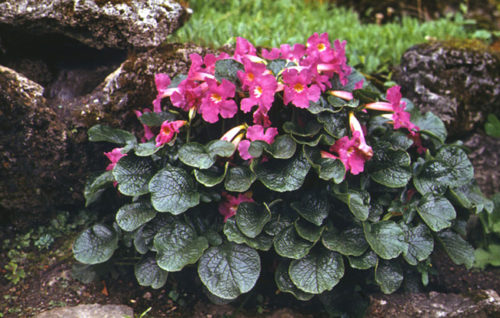
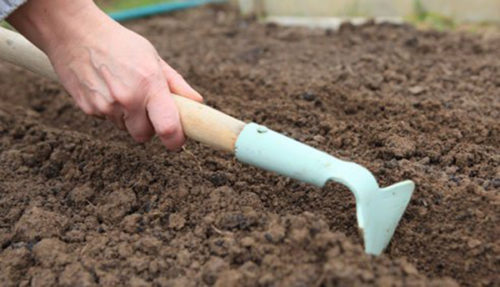
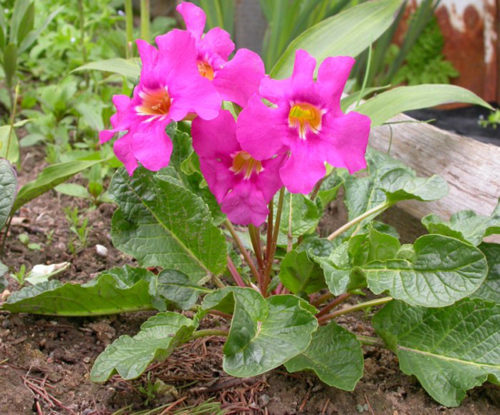
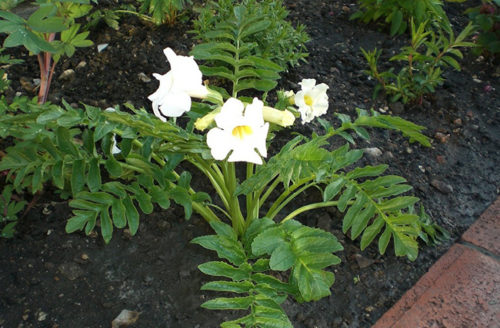
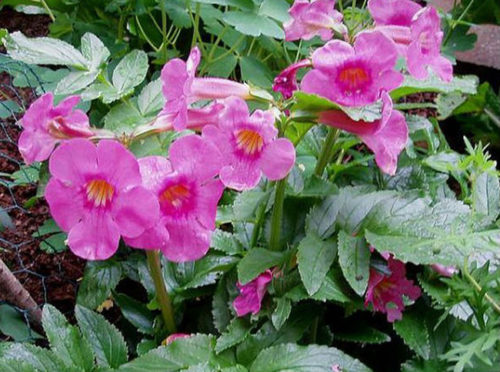
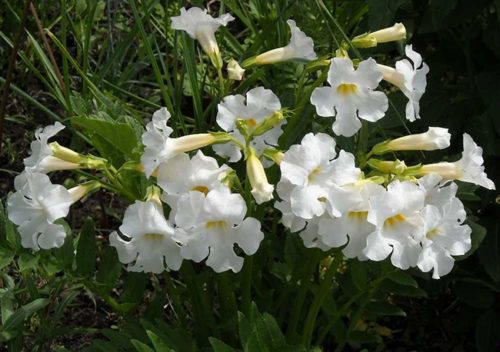
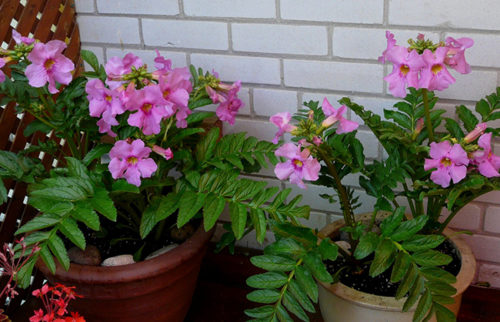
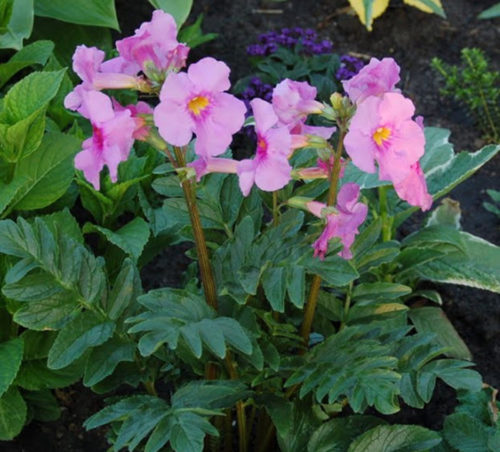












 Start a discussion ...
Start a discussion ...